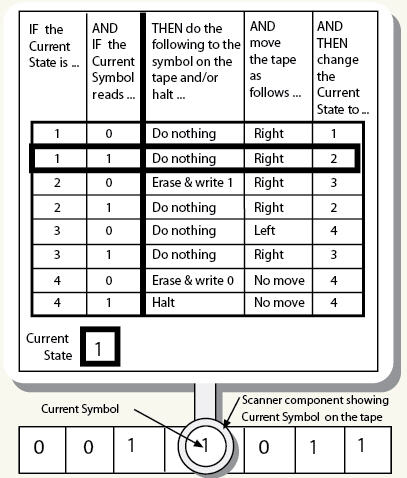Hilary Putnam (1967).
Turing MachinesThe Turing machine arose in the context of attempts by mathematicians to specify precisely what an algorithm was. Alan Turing's insight was that any algorithm could be carried out by one of a class of Turing machines. Indeed, he proved that an algorithmic procedure (or, an
effective procedure) is just a procedure that can be implemented by a device that blindly and deterministically manipulates symbols. So Turing machines precisely define the concept of an algorithm.

A Turing machine is conceived of as an imaginary device that manipulates symbols on a tape. The behaviour of a Turing machine is determined by the state it is in and by the symbol it reads on the tape. Based on these two factors, the machine will do any or all of the following:
- enter a new state,
- write a symbol on the tape
- moved to the right
- or to the left
- or halt.
The table of rules (or
machine table) correlating these actions with states and symbols exhaustively specifies a given machine. Based on its machine table we can determine exactly what a Turing machine will do with any given tape.
A
Universal Turing Machine is a Turing machine that can perform all the calculations of any other Turing machine. To emulate a given machine, the Universal Turing Machine is programmed with a special tape that fully describes the emulated machine's table.
Note: also see the "
Can Automata think?" arguments on Map 7.
Any system that possesses a mental life is simply a complex Turing Machine instantiating a certain machine table. Each mental state (a thought, e.g.) is actually a machine state that arises in the course of that program. As such, every mental state can only be defined as part of a network of sensory inputs, other mental states, and behavioral outputs. So a computer, programmed with the correct machine table, could think.
The Putnam argumentHilary Putnam is generally credited with proposing the functionalist position. He writes:
"I propose the hypothesis that pain, or the state of being in pain, is a functional state of a whole organism....
I shall assume the notion of a Probabilistic Automaton has been generalized to allow for "sensory inputs," and "motor outputs"--that is, the Machine Table specifies, for every possible combination of a "state" and a complete set of "sensory inputs," an "instruction" which determines the probability of the next "state," and also the probabilities of the "motor outputs." (This replaces the idea of the Machine as printing on a tape.) I shall also assume that the physical realization of the sense organs responsible for the various inputs, and of the motor organs, is specified, but that the "states" and the "inputs" themselves are, as usual, specified only "implicitly"--i.e., by the set of transition probabilities given by the Machine Table....
A Description of S where S is a system, is any true statement to the effect that S possesses distinct states S1, S2 ..., Sn which are related to one another and to the motor outputs and sensory inputs by the transition probabilities given in such-and-such a Machine Table" (H. Putnam, 1967, p. 199).
ReferencesPutnam, Hilary. 1967. The nature of mental states. In
The Nature of Mind, edited by Rosenthal, pp. 197-203. Originally published as "Psychological predicates" in
Art, Mind, and Religion, edited by W.H. Capitan and D.D. Merill, pp. 37-48.